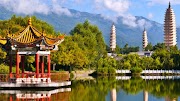Luneta Park and Intramuros, Manila
Rediscovering the rich cultural heritage of the Philippines!
For everyone, December 24 is a busy day of preparation for Christmas Eve, but I and my friend, Lea, decided to spend it outdoor, strolling around the historical landmarks in Manila :-D
Two of the most famous tourist attractions in Manila, Philippines that reflect the country's long struggle for independence and freedom are Luneta Park and Intramuros. These historical sites embody the Philippines' unique culture and ancestry. So if you want to get an additional piece of knowledge about the country's glorious past and cultural orientation, try to include Luneta Park and Intramuros in your itinerary of travel when coming to Manila.
LUNETA PARK
Located along Roxas Boulevard, Ermita, Manila, this urban park officially known as Rizal Park, is a massive complex of gardens, Philippine Heroes’ markers, plants and a playground. It is beautifully covered with manicured lawn, cobbled stone pathways, green plants, flowers and water fountain. There’s a large Philippine map carved in stone situated in the middle of the river near the foot bridge of the park.
Philippine map carved in stone
The park has several souvenir’s shops where you can buy gift items at an affordable price. It has park benches along the pathways. You will also find mini-shuttles and Kalisa (horse-drawn carriage, Philippine’s oldest form of transportation) that would take you around the area for sightseeing, rate ranges from 30 pesos to 50 pesos.
Two of the most famous monuments inside the park are that of Dr. Jose Rizal, Philippine national hero who fought during the Spanish era in the 19th century, and Lapu-Lapu, a tribal chieftain in the visayas region, hailed as one of the early Philippine heroes who famously led the resistance of the Cebuanos against the Spaniards in the 16th century. Lapu-Lapu's monument is a gift from the people of South Korea.
At the monument of Lapu-Lapu
Luneta Park is an important site of Philippine history, it is where Dr. Jose Rizal executed on December 30, 1896. The site marker of his execution can be found not far from the water fountain. His monument, made of bronze and granite, is closely guarded by military personnels and visitors are not allowed to go closer to the vicinity of the monument.
Monument of Philippine National Hero, Dr. Jose Rizal
The best time to visit Luneta park is during mid-afternoon and early evening where the environment is cooler and soothing. You will feel the relaxing breeze of the soft air coming from the Manila bay. The sprawling area is ideal for unwinding, dry picnic and simply bonding moment with friends and family.
Visitors are allowed to bring food inside the park, just bring with you a sheet to spread in the grass for your dry picnic. But not all areas in the park are available for resting, the manicured lawn with the greenest grass is off limit to visitors, just ask the guard on duties where to stay for a dry picnic to avoid being reprimanded.
Visitors are allowed to bring food inside the park, just bring with you a sheet to spread in the grass for your dry picnic. But not all areas in the park are available for resting, the manicured lawn with the greenest grass is off limit to visitors, just ask the guard on duties where to stay for a dry picnic to avoid being reprimanded.
Other tourist sites and landmarks within the park are Japanese garden, Chinese garden, Children's playground, Museum, Department of Tourism, the National Library, Luntiang Pilipinas garden, Quirino Grandstand, Kilometer Zero marker, which serves as a point where all road distances from Manila are measured, Harbor View and Manila Ocean Park.
Nearest Landmarks and Establishments in Luneta Park:
1. Bayview Park Hotel Manila
2. Hotel H2O
3. La Luneta Apartment
4. Manila City Hall
5. Manila Hotel
6. Manila Pavilion Hotel and Casino
7. NBI
8. SM Manila
9. Supreme Court
10. The Corporate Inn Hotel
11. University of the Philippines-Manila
12. Philippine General Hospital
Nearest Landmarks and Establishments in Luneta Park:
1. Bayview Park Hotel Manila
2. Hotel H2O
3. La Luneta Apartment
4. Manila City Hall
5. Manila Hotel
6. Manila Pavilion Hotel and Casino
7. NBI
8. SM Manila
9. Supreme Court
10. The Corporate Inn Hotel
11. University of the Philippines-Manila
12. Philippine General Hospital
How to get there?
If you are traveling via LRT, alight at the United Nations Station, Luneta Park is just few steps from the exit area of the station. If you are traveling via the public utility jeep, disembark at the Kalaw street and walk straight ahead. Entrance Fee to the park is free.
INTRAMUROS
This is one area in Manila where you can still experience the atmosphere of the Spanish culture.
Known as the Walled City, this ancient complex, which is preserved by the Philippine government to commemorate the country’s journey to freedom and independence, echoes the interesting past of the nation especially during Spanish colonialism.
Known as the Walled City, this ancient complex, which is preserved by the Philippine government to commemorate the country’s journey to freedom and independence, echoes the interesting past of the nation especially during Spanish colonialism.
Intramuros (Latin for "within the walls") is just as interesting as the country's tradition and culture, it will take you back in time to the old days of the Spanish Society.
Upper part of the walled city just in front of San Juan de Letran
Lyceum of the Philippines inside Intramuros
Built around the 16th century, Intramuros is one of the fewest remaining landmarks in the Metro where visitors can experience the Spanish-era Manila through its streets, restaurants, stores, buildings and churches. Within the wall lies Fort Santiago, originally built as a defensive fortress of Spaniards but later transformed into a prison wall.
Intramuros was originally used as the seat of government of the Spaniards in the Philippines and was declared the capital of the new Spanish Colony. The defensive walls were built to protect the city from foreign invasions. It was heavily damaged during World War II but reconstructed in 1951 to preserve the cultural heritage of the Filipino people. The site was consequently declared the National Historical Monument.
Entrance to Fort Santiago near the Pasig river
When you visit this place, you will be surprised with the ancient appearance of the environment, even the guards on duty are wearing the Spanish-era tailored uniform. The cobbled streets look like the old days, very quiet and peaceful, the pathways and walls have no traces of modernization, felt like you are traveling back in time and as you walk through the quiet street, you will see the ancient structures of buildings and stores.
There are educational institutions inside the walled city: Mapua Institute of Technology, San Juan de Letran, Collegio de Sta. Rosa and Lyceum of the Philippines.
How to get there?
Intramuros is accessible by any types of transportation. If you are traveling via LRT, you may alight at the Central station then walk ahead across Manila City Hall, you will pass two intersections, from there you will see a fenced lawn and ahead of that is the entrance of Intramuros. If you are traveling via public utility vehicles, choose the routes going to Lawton/SM Manila or Pier. Intramuros is just around the area.
In my experience visiting Intramuros with a friend, we just walked from Luneta Park to Manila City Hall then we crossed the street on the left side, and headed to Intramuros.
Nearest Landmarks and establishments in Intramuros:
1. Bayleaf Intramuros Hotel
2. Manila City hall
3. Palacio del Gubernador
4. SM Manila
5. US Embassy
6. White Knight Hotel Intramuros
-->




















0 Comments